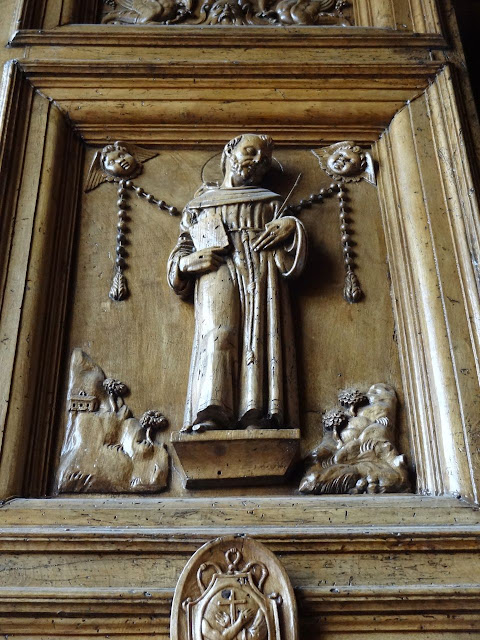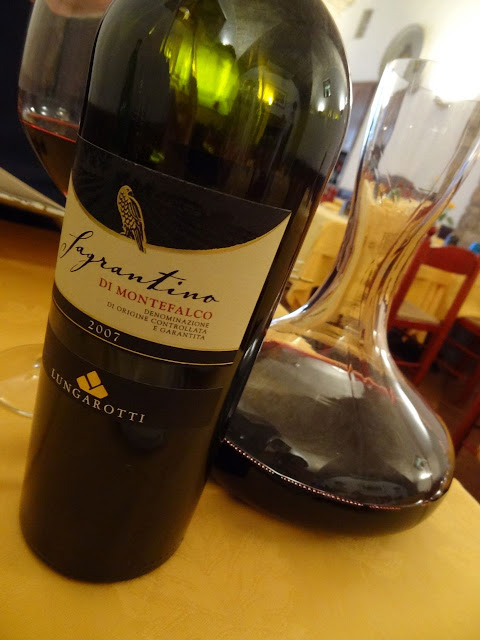Assisi is the birthplace of St. Francis, who was born Giovanni Francesco di Bernardone in 1182 and later founded the Franciscan Order and Women’s Order of St. Clare. Thousands come to worship in Assisi's magnificent churches, and to pray to Francis of Assisi, the patron saint of Italy affectionately called Il Poverello because he lived and preached a life of simplicity and poverty. Famous for its spectacular Basilica di San Francesco, built in the 13th century, Assisi is worth visiting even without the churches, extraordinary frescoes and associations with St Francis. Founded by the Umbrians, Assisi was prominent during the Roman era but achieved its greatest fame and importance during the Middle ages. The town still retains the architectural flavour of these times, as we enjoyed strolling through its extraordinary squares and streets.
Assisi's Lion Fountain in the town's main square of Piazza del Commune
The 1st century BC Temple of Minerva and 13th century Torre del Popolo
Roman columns flank the doors to the Temple of Minerva
Temple of Minerva, now a Christian church — Santa Maria Sopra Minerva —
with its spectacular ceiling, an unexpected wonder
One of the older sites within the ancient town is the former Temple of Minerva, now a Christian church, Santa Maria Sopra Minerva. The entire Roman facade, with its imposing Corinthian columns are from the first century BC. After several centuries of abandonment, 6th century Benedictine monks began to restore the space, but from the 13th to the early 16th century, the temple was even used as a city jail! In 1539, Pope Paul III ordered the inner sanctum to be completely restored. The church nave now is decorated in an extravagant Baroque style, which is unbelievably beautiful, but the contrast to the classical exterior is quite shocking.
Cobblestone streets wind their way through the maze of Assisi's walled old town,
an atmospheric blend of Roman and Medieval influences
Wandering through Assisi is a walk through history
A view over the Umbrian countryside through a Roman archway in Assisi
Perched on a cliff along the walls of Assisi, the approach to the Basilica di San Francesco can be overpowering. A few months after St Francis died in 1226, Frate Elia, Vicar-General of the Franciscan Order, was commanded by Pope Gregory IX to construct a church dedicated to the saint, however it wasn't without controversy that Frate Elia erected such a grandiose building to hold the relics of a saint who had preached poverty during his life.
Basilica di San Francesco was built on two levels: the upper Basilica and the lower Church,
the simpler burial place of St Francis
Sculpture on the front lawn of the Basilica depicting St Francis as a soldier
before he devoted himself to a life of poverty
The Basilica, which was begun in 1228, is comprised of two churches known as the Upper Church and the Lower Church, with a crypt on the lower level where the remains and relics of St Francis are interred. The Basilica, with its accompanying friary, is a distinctive landmark when approaching the hilltop town of Assisi. One of the most important stops for Christian pilgrims visiting Italy, Assisi has been a UNESCO World Heritage Site since 2000. The Basilica's breathtaking interior and world famous frescoes, painted by the greatest artists of the time including Giotto and Cimabue, portray the life of St Francis as well as scenes from the Old and New Testament.
The fabulous vaulted interior of frescoes chronicling the life of St Francis
Fresco of St. Francis Sermon to the Birds, by Giotto
St. Francis and St. Clare, by Giotto
While we were visiting the Basilica, a boys choir suddenly began to sing in one of the small chapels. Their young voices filled the church with such a joyous sound, it brought tears to my eyes. Such a chance happening made the whole experience even more special, if that were possible. An exquisite church with an unprecedented collection of priceless frescoes, it was tragic, when in 1997, massive earthquakes hit Assisi, causing enormous damage to the Basilca and the fragile frescoes located within. Astoundingly, the restoration was done in record time, and the Basilica was reopened just two years later.
Carving of St Francis on the front doors to the Basilica
The interior courtyard outside the Basilica
The burial tomb of St Francis of Assisi
In addition to Assisi's religious and cultural highlights, Assisi is also famous for its fine restaurants. Having heard about a wonderful restaurant off the main square of Piazza de Comune, we headed up the winding streets to find Ristorante La Fortezza, a charming trattoria nestled on one of Assisi's winding vicolas.
Ristorante La Fortezza on Vicolo della Fortezza, up from Piazza del Comune
La Fortezza menu and view of Roman ruins through a glass-covered vault in the floor
Built on Roman ruins, the restaurant has installed translucent glass on the floors to highlight the unique foundations they inherited almost 50 years ago, when the family run restaurant first opened its doors in Assisi. Specializing in regional Umbrian cooking with a focus on local Assisi dishes, we started our lunch with a bottle of Sagrantino di Montefalco — a delicious Umbrian wine from north of Spoleto.
A delicious Umbrian Sagrantino di Montefalco by Lungarotti
An amuse-bouche of Umbrian crostini - chicken liver and fresh cheese
As we enjoyed our wine and parused the menu, a plate of crostini arrived to whet our appetite. We decided on Il Nostri Gnocchi alle Verdure, homemade potato dumplings in a blended sauce of sausage, tomatoes and seasonal Umbrian vegetables. Light and delicate, the gnocchi were like little pillows of air. One of La Fortezza's specialties is their Cannelloni all'Assisana, a heavenly chicken and pork filled pasta baked in a rich tomato and béchamel sauce. To follow we enjoyed the Agnello alla Griglia and Arista di Maiale alla Spedino, roast pork grilled on the spit. For contorni, or side dishes, we tried the Funghi Porcini Tricolore, thinly sliced fresh porcini mushrooms cooked in olive oil, garlic and white wine, as well as a luscious Melanzalla Forno Parmigiana, baked eggplant in a tomato parmesan sauce.
Il Nostri Gnocchi alle Verdure
Cannelonni all'Assisana
Agnello alla Griglia
On the way back to Casa del Lauro, we felt compelled to stop by one of Assisi's famous Pasticcerias for some of the town's renowned Tortas — large domed cakes filled with pistacchio, chocolate, lemon and even Perugia's darling — Baci cholcolates.
One of Assisi's renowned Pasticcerias with traditional sweets
An Assisan specialty — enormous dome-shaped tortas
An enormous Baci-style torta
An Assisi tradition of sinfully sweet confections
Assisi meringues — as large a child's head!





























No comments:
Post a Comment